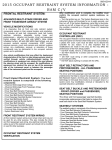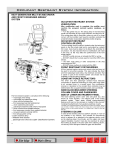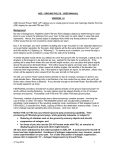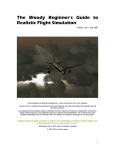Download Interview with Jad Abizeid:
Transcript
L E B A N O N V I R T U A L S C E N E R Y D E V E L O P E M E N T F O R F L I G H T S I M U L A T I O N blog Interview with Jad Abizeid: A Professional Pilot, Lebor Simulations co-founder and OLBAX Lead Designer. What made you discover the love for aviation in yourself and at what age? It was very normal for me to be connected to aviation due to its presence in the family long before I was born. As a young boy, I had a sense of pride watching my father from the window wearing his full uniform carrying his big suitcase and a Jeppesen Flight bag, walking to his car in the morning to drive to the airport. It felt so nice (but inappropriate) I thought I was him. But all this has nothing to do with love of aviation. I was more into wildlife at that time... Up until my elder brother installed a copy of “Chuck Yeager’s Advanced Flight Trainer” on our first IBM compatible PC. We called dad and asked him to explain to us what all this is about. After that day I kept fooling around with this simulator, if I remember you could fly underneath an open hangar and between buildings and pyramids, etc... I used to take the F-16 to see how fast it was compared to the Cessna, it was really nice. Well there started my love of simulation; I guess I was sixteen or seventeen. But this was not the reason I became a pilot, I never thought I wanted to be one until my last year of high school. Please tell us a little bit about your career in aviation and your future goals... My career in aviation is nothing to be proud of, delays, delays and more delays. At first I wanted to join Middle East Airlines like everybody else, but the company was not hiring, so I went to Oklahoma to learn to make fry (how to fly) Avgas was cheap over there and the weather was good. And I discovered one more benefit while I was there; once you’re done with a checkride you can drive with the Designated Examiner or a Flight School representative to Mike Monroney Aeronautical Center in Oke (Oklahoma) City and get your license on the spot instead of waiting for it to come by mail. Returning to the subject, when I was done, I came back to Lebanon to convert my license to a Lebanese one, it took me eight months waiting for the civil aviation to assign a date for the written and the oral exam. I was one of the last pilots to be given such an oral exam, at that time you would sit in a conference room in front of a committee of four to five people: Director of Flight Safety, Director of ATC, Maintenance and Engineering rep, Meteorology rep etc... It was a bit hard to cope with what they wanted because they were still using a system used in the sixties, but they were satisfied with my answers (since I passed). From there on the headwinds started picking up, I had to lose one year for the military service, then September 11 happened when I was newly hired at JR Executive, everything went to a standstill, then I had a chance with MEA in 2004 for direct entry pilots for the first time in MEA’s new history, sadly my FAA license was not good enough for them even after I’ve done all what they asked me to, they needed a what was known by JAR license (EASA), I would give a black point to this person who wasted my time, anyway, so this guy decides that I would be accepted as a cadet applicant and have to start from scratch and pay for everything. It is a pity MEA don’t allow their qualified employees to give proper recruiting interviews. I didn’t like the idea of going back to school when I was already a flight instructor, I went on, and worked as a freelance pilot for Flying Carpet, then was hired by Space Imaging Middle East in Dubai for aerial survey. Then joined Menajet on the A320 until they shut down, and now I am waiting for interviews in the Arabian Gulf area, I still do aerial survey if I have the time. Future goals, well, I have been hammered a lot through my aviation career that a decent job with a decent revenue would be more than satisfying. What made you interested in flight simulation and with what version of MS FS you had the first contact? As I mentioned before my first contact with Simming was with Chuck Yeager’s Trainer. Believe it or not his comments, when I did bad, hurt me, I was taking it seriously, that is so funny. Then came the Combat Sim: “F-117A Night Stealth Fighter” you hade to fly missions and avoid fighters and return home before you run out of fuel. Then I discovered MSFS4.0, then 5 then 5.1, my brother knew how to install a new panel for an Air Canada B767 add-on I had, I was fascinated, of course he was the computer whiz, I just wanted to fly. From there on every time I hear that Microsoft released a new Flight Simulator I go and get it. FS95 had the first B737, I remember the first time I was trying it my heart was beating, I was very tense again I was taking it seriously... Allot of professional pilots snob FS or any other PC flight simulator and consider it “just a game”. Being an airline pilot now and an instructor at one point of your career, how do you perceive PC Flight Simulators: are they inexpensive tools to introduce flying to beginners or simply another genre of pc games? Flight Simmers are immersed in a virtual reality world that keeps getting more realistic, once they master the sim, they have the wrong feeling of being accomplished pilots, they actually live their virtual reality; Whereas professional pilots had to go through exhaustive training and sometimes dangerous situations to get to the point where they are. Pro Pilots don’t snob FS, they snob Flight Simmers, don’t forget that every PC simulator was tested by real pilots before being released. I have showed FS to many MEA captains and they enjoyed it, especially flying the C172 as well as Captain Sim’s B707 with MEA liveries. You were right in your question when you said that Pro Pilots consider PC flight simulators as just a game, I want to make everybody happy and say that it is a game for honing real aviation skills. FS will prepare you for many lessons that you take in flight schools, but they would never be a substitute to actual simulators and real flying. A simple example is engine noise: stuttering, backfiring, misfiring, vibrating etc... you can tell if something is wrong by hearing and feeling, in this case FS would be giving you a false feeling that engines are monotone, when did you ever think to listen to your engine while flying FS? Have you ever had a sudden engine failure without you planning for it? If you had one, have you ever performed the proper checklists while keeping control of your distressed aircraft? Could you see if the field you are landing on is appropriate for a forced landing? Nevertheless in the latest versions of MSFS you can find interesting flight lessons that can get you up and running so that you can learn to perform realistic tasks, realistic but isolated. It is one step further than the books but still behind the real thing. So FS will never teach you to become a real pilot but it sure will teach you to become a better prepared pilot in those specific tasks while saving a lot of money! If you think a PC Flight Simulator can teach the basics of flying to beginners, do you have any tip or advice to get the most of a PC flight simulator as a learning tool? For beginners, I would like them to treat aviation as they would treat their own body and health. It is good to start up flight simulator and try to practice, but always ask your instructor how would practicing a certain lesson on the sim be more beneficial, if ever it is ok to practice it at the first place. Make sure you use your checklist every time at the various phases of the flight. Using a checklist is as critical as selecting the gear down for landing, it is something you should never omit. It could be a tiny distraction at the beginning but once you get used to it it becomes second nature. So force yourself to use the “CHECKLIST”. Another way of using FS is for area familiarization. New FS versions allow satellite and aerial imagery and real digital terrain models to be integrated inside the simulator, imagine that you can have real lakes, seashores and mountains this will help instructors to show you where the practice area is and how to get there and what places to avoid, of course instructors should always be using their sectional charts as the only official source. Let me explain to the instructors now that FS will make their life much easier especially when teaching instrument flying, you know there are several training videos you can get your students to watch during ground school, and these videos try to answer most of the questions a student could ask, but not everything, you as an instructor can demonstrate every Instrument lesson you can think of with FS. Set it up on your over head projector and fly the aircraft around, slew the aircraft around or let the autopilot do the job. How did you get interested in scenery design for flight simulation? First I was very interested in sceneries and airplane liveries for Lebanon, it was 1997 when I discovered Emile Elias’s Beirut scenery and Konstantin Kouchary’s fictional MEA 737 livery, then Konstantin created “Wings over Lebanon”, I remember I sent him a compliment e-mail to encourage gathering sceneries and aircraft for Lebanon, because at that time our part of the world was neglected in MSFS. That happened when I was still in the US and he was so kind to offer me any help needed. Then there were two active WOL members that were giving from their own time to enhance Lebanese FS experience, Michel Karam and Mike(Moe) Kara, I was following up what they were doing until came a moment where I had to contact and congratulate them. I would say these people and a few others were the foundation of Lebanese PC flight simulation. I still was a receiver and not a contributor, until I released Lebanon Elevation Mesh for FS2000. Then gmax appeared, and I had to self teach myself how to use it to create objects, I started with simple objects then created the cross on Mount Krizevac after an awesome Christmas trip to Medjugorje, I installed it in FS2004 and it worked! It was never published but now I knew that I can contribute more to realistic FS scenery! How did you meet Michel Karam and how was Lebor Simulations founded? As I already mentioned, I knew Michel since he was a member of WOL, the year was 1998 or 1999, he was busy creating Beirut 99 under a group called Lebor that he created and managed. By then I was not even a beta tester. Lebor Simulations has its roots in “Lebor”: the famous freeware scenery provider that is known to many Lebanese simmers. The name “Lebor Simulations” was given to the group for a fresh startup on their 10th anniversary along with a new logo. Again it wouldn’t have been possible without the magic fingers of Michel Karam, who by the way is a dedicated graphic designer and painter. I have known Michel and am in uninterrupted contact with him for eleven years now but funny enough I have met him only twice, he lives in Montreal and I linger east of the Mediterranean Sea! Please tell us a little bit about the scenery projects you designed so far at Lebor... Lebor was overwhelming to me; you see I love my country and was very happy someone was promoting it for free. Now to become a member of Lebor is more or less a serious issue, your products had to meet certain standards, I was administered to the team when I released the elevation mesh in October 2001, then I worked on the new SRTM elevation mesh for FS2004, after that I used Gmax for Our Lady of Lebanon, which took a great deal of 3D modeling learning. Then came the Lebanese coastline along with Quaraoun Lake. Now an SRTM mesh for FSX is ready along with the coastline with the small islands and lakes, they will be released in due time. What is your typical day of scenery design or can you please summarize how you proceed when designing? It is very hard to find decent time to work on designing, sometimes there are huge gaps that extend months. Scenery production goes through several phases; I can summarize them as follows: 1. Decide on what kind of project, is it elevation modeling, landclass, coastlines, satellite imagery, buildings, airport tune ups, airports from the ground up etc... 2. Decide on the level of realism you want to incorporate in your product. 3. Read the SDK documents relative to the FS version you want to design, it normally would be supplied with the simulator, once done reading it, read it again, once done reading it again, read it again. You don’t believe how deep this SDK goes especially the FSX one. 4. Gather all data required and organize them in folders. 5. Search for tools that would make your life easier, of course all the tools you need come with the SDK but not all are user friendly, on the other hand many freeware developers are creating nice tools with visual interfaces that replace the DOS command prompt window. These tools are based on the SDK tools, so now you have to read the FS SDK and the tools’ user manual. Believe me it will avoid a lot of frustration. If you are not a sit and read type of person, forget about it. 6. Decide on what you need to accomplish step by step. 7. Give the files you create meaningful names with serial numbers, something you can keep track of. 8. Always make back-ups. 9. Whenever you hit a wall, go to fsdeveloper.com, you will find extensive information on how to proceed to solve your problem. What are the limitations or frustrations a scenery designer could face when working on a project? The number one frustration for me is lack of TIME, people are sometimes impatient for a release, believe me I am even more impatient! You get frustration from the lack of data or decent data that you need. Computer crashes and slow computers are a big contributor especially when you have to test your scenery ten times an hour, also unstable electric power that fries my power supplies. Flight Sim limitations can become a pain… Sometimes a stupid mistake can ruin a whole day of work. I thank you for asking the question, it has to be clear to flight simmers that sceneries we design take a lot of energy to work out properly, if you fly at 200 knots over a scenery area of 4 square kilometers you might pass it in 30 seconds, but for it to be there at the first place took hours and hours of hard work and frustration, so I appreciate if this is taken into account. How do you see the future of Lebor Simulations and the scenery projects? Lebor Simulations would want to carry the flame to the end, and as long as there is free time it will always be delivering the cool stuff, there might be a chance that future products would have a price tag on them, but it hasn’t been decided when nor what type of customer would this apply to. Knowing that the world of flight simulators is uncertain with the FS franchise being halted by MS, do you have any hope for the future of PC Flight Simulators? From my point of view PC based Flight Simulations whether civilian or military are here to stay and flourish, I have no fear whatsoever on their future. As we speak the newly founded Cascade Game Foundry is hard at work a new PC simulator. I am full of hope! What is your experience with Laminar Research XPlane and do you think Lebor Simulations will shift its activities toward this platform or even better make Lebor sceneries available for both FS and XPlane? I have been using Austin Meyer’s X-plane ever since it was a freeware, and I find it a really interesting sim for the serious guys out there, once OLBAX is released for FSX, I will try to export it to X-plane, who knows, it could turn out better over there, stay put on this one! Any advice or tip you would like to give for beginners in aviation? My advice to beginners in aviation is not to forget why they started this journey, and it better not be to impress their girlfriend/boyfriend! You also have to understand that the joy of sharing the skies with eagles will come with a very big price tag and hard hours at work, but at the end it is worth every penny and every minute you spend. Any advice or tip you would like to give for beginners in scenery design? Same here, you have to like designing and treat it as an artist would with his painting, give it the time, go away for a while and then come back with a clear conscious and a fresh mind. Always do your readings, remember that the tools you are using took years to be what they are at the moment, just like cell phones, remember the first bulky one and the one you are using now, so be thankful to the developers and read their instructions and notes thoroughly else you will never fully benefit from their products. At the end be organized and remain consistent. I would like to take the opportunity to thank all developers and designers for all that they have given us especially the freeware products, I also would like to encourage Lebanese enthusiasts to join Lebor Simulations and give more to their country. Wishing everyone all the best! Happy New Year 2010! Jad Abizeid LEBOR Simulations | December 23, 2009 www.leborsim.com











